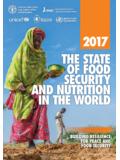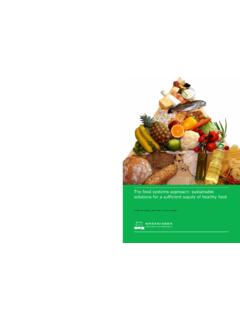Transcription of Water for Sustainable Food and Agriculture
1 Water for Sustainable food and Agriculture A report pro duced for the G 20 Presid ency of Germany Water for Sustainable food and Agriculture A report produced for the G20 Presidency of Germany food and Agriculture Organization of the United Nations Rome, 2017 The designations employed and the presentation of material in this information product do not imply the expression of any opinion whatsoever on the part of the food and Agriculture Organization of the United Nations (FAO) concerning the legal or development status of any country, territory, city or area or of its authorities, or concerning the delimitation of its frontiers or boundaries.
2 The mention of specific companies or products of manufacturers, whether or not these have been patented, does not imply that these have been endorsed or recommended by FAO in preference to others of a similar nature that are not mentioned. The views expressed in this information product are those of the author(s) and do not necessarily reflect the views or policies of FAO. ISBN 978-92-5-109977-3 FAO, 2017 FAO encourages the use, reproduction and dissemination of material in this information product. Except where otherwise indicated, material may be copied, downloaded and printed for private study, research and teaching purposes, or for use in non-commercial products or services, provided that appropriate acknowledgement of FAO as the source and copyright holder is given and that FAO s endorsement of users views, products or services is not implied in any way.
3 All requests for translation and adaptation rights, and for resale and other commercial use rights should be made via or addressed to FAO information products are available on the FAO website ( ) and can be purchased through iv Contents 1. 2. Critical issues affecting the global outlook for Water and food 3. Recommendations for (i) Recommendations under the Agriculture (ii) Recommendations under the Water 1 1. Introduction 2. Water is essential for every form of life, for all aspects of socio-economic development, and for the maintenance of healthy ecosystems.
4 While there are sufficient freshwater resources at the global level to enable continued agricultural and industrial development, the long-term Sustainable use of Water resources is of growing This is particularly the case when considering the intrinsic disparity in Water quality and availability across regions. Box 1: Water facts and figures2 Water use grew at almost twice the rate of population increase in the last century. Although there is no global Water scarcity as such, an increasing number of regions are chronically short of Water .
5 Other regions suffer the consequences of unmet demand due to infrastructure or institutional inadequacies. On average, Agriculture accounts for 70 percent of global freshwater withdrawals. In the last 30 years, food production has increased by more than 100 percent. FAO estimates that about 60 percent more food will be needed by 2050 to meet the food requirements of a growing global population. Water demand is therefore set to increase. FAO projects that irrigated food production will increase by more than 50 percent by 2050, but the amount of Water withdrawn by Agriculture can increase by only 10 percent, provided that irrigation practices are improved and yields increase.
6 The world contains an estimated 1 400 million cubic km of Water . But only of this vast amount, about 45 000 cubic km, are fresh Water resources that could be used for drinking, hygiene, Agriculture and industry. But not all of this Water is accessible because part of it flows into remote rivers during seasonal floods. It takes between 1 and 3 tonnes of Water to grown 1kg of cereal. A kilogram of beef takes up to 15 tonnes of Water to produce. FAO estimates that between 2 000 and 5 000 litres of Water are needed to produce a person s daily food .
7 3. The 2030 Agenda for Sustainable Development and the Sustainable Development Goals (SDGs), and the Paris Agreement under the United Nations Framework Convention on Climate Change (UNFCCC) provide both the framework and the targets that should guide global efforts towards more inclusive growth and Sustainable livelihoods. Agriculture , through its links to food security, nutrition and health, rural development and growth, and the environment, is a major driver in the attainment of these 1 FAO.
8 2015. Towards a Water and food secure future: critical perspectives for policy-makers. food and Agriculture Organization of the United Nations, Rome and World Water Council, Marseille. 61 pp. (also available at: ). 2 FAO. Water at a Glance: the relationship between Water , Agriculture , food security and poverty. Rome. 15 pp. (also available at ) 2 targets. In the current environment of changing global agricultural markets, Agriculture faces a triple challenge. First, it has to increase the production of safe and nutritious food to meet a growing demand driven by population increase.
9 Second, Agriculture has to generate jobs and incomes and contribute to poverty eradication and rural economic growth. Finally, Agriculture has a major role to play in the Sustainable management of natural resources and the adaptation to, and mitigation of climate change which is already affecting the livelihoods of many people, especially the most vulnerable. 4. Agriculture is the largest Water user worldwide, accounting for 70 percent of total freshwater withdrawals on average3 but these amounts can reach as much as 95 percent in some developing Agriculture is also a major source of Water pollution from nutrients, pesticides and other contaminants, which if unmanaged can lead to significant social, economic and environmental costs.
10 5. Improving agricultural productivity, while conserving and enhancing natural resources, such as Water , is an essential requirement for farmers to increase global food supplies on a Sustainable basis. The role of smallholder farmers and their families in increasing agricultural productivity growth sustainably will be crucial. Farmers are at the centre of any process of change involving natural resources and need to be encouraged and guided, through appropriate incentives and governance practices, to conserve natural ecosystems and their biodiversity, and minimize the negative impact Agriculture can have on the environment.











